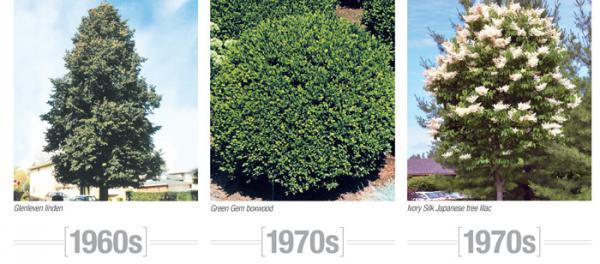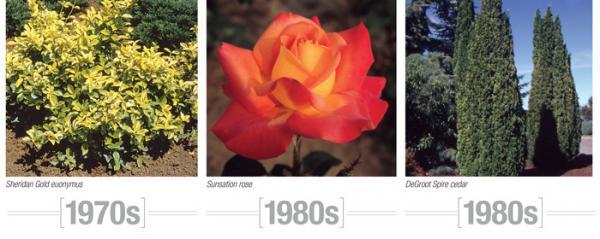March 26, 2013

Canadian contributions
BY LAWRENCE C. SHERKSince its inception in 1913, Sheridan Nurseries has had an extraordinary influence on the plant palette available to Canadian gardener. In recognition of the nursery's 100th anniversary, Larry Sherk takes a look back at some of the notable cultivars Sheridan growers have introduced in the last century.
The year 1940 saw Sheridan Nurseries introduce seven hardy Chrysanthemums with names such as Carl Borgstrom and Mrs. Dunington-Grubb. Eight were introduced in the 1941 catalogue and nine more over the next 20 years. They were developed by a Sheridan nurseryman, Gus Sparre, who came to Sheridan in the 1920s from Denmark. Although he left and went to Clarkson Greenhouses (later Clargreen) in 1943, he continued to release garden mums through Sheridan Nurseries until 1959 (Karl Stensson) and 1960 (Sheridan Bronze). Some of these mums were last listed in the 1965 catalogue. U.S. rights to at least one mum was sold to Wayside Gardens, then in Mentor, Ohio, and renamed Mme. Chiang-Kai-Shek. It was introduced in their 1945 catalogue, which noted “We consider it the finest chrysanthemum in our collection, if not the finest in the country.”
Several other herbaceous perennials have been selected and introduced by Sheridan Nurseries over the years. These included the Sheridan shasta daisy (1941); Sheridan Pink phlox (1946); Sheridan Purple phlox (1951); Sherway phlox (1958); Viola cornuta ‘Sherway Perpetual’ (1970); Mrs Cornell shasta daisy, described as hardy and semi-double (1975); and the Springsyde daylily in 1973. Only the Springsyde daylily, a compact yellow cultivar, is still grown today. Most of these perennials were selected by Jim Herod, who prided himself as a grower of quality herbaceous perennials.
The first Sheridan selection of a woody plant to be named was Sheridan’s Red barberry, first introduced as a cultivar of Berberis thunbergii but subsequently listed only as a cultivar without a species epitate, as it was probably a hybrid of the Japanese barberry and the common barberry, It was described as being taller and having much darker purple foliage than the redleaf Japanese barberry. This hybrid parentage would lead to its downfall as Agriculture Canada banned many deciduous barberries as being alternate hosts of black stem rust on wheat. It was last listed in 1965.

Ornamental evergreens
The next major Sheridan selection was to become much more successful: Juniperus chinensis or ‘Mountbatten’ selected from a field of seedling Chinese junipers. It was introduced in the 1949 catalogue, and described as having a “compact pyramidal habit” without trimming, rapid growth, attractive silvery green colour, and hardiness. Lord Mountbatten had opened the Canadian National Exhibition C.N.E. in August 1948 and graciously consented to the use of his name when approached by Fred Stensson.
Other prominent evergreens included two cedars selected from a population of seedlings. One was the Unicorn cedar, released in 1980 as a denser selection of the Pyramidal Cedar, a popular hedge plant. At the same time, a much narrower cedar was selected by Constant DeGroot, and named DeGroot Spire cedar by Sheridan Nurseries. It found favour with West Coast nurseries because of its extremely narrow growth habit. But it was not put into production at Sheridan Nurseries until the late 1990s, when its narrow stature meant it was very useful for smaller patio gardens that were becoming more widespread.
Garden-worthy trees
The Sheridan Spire dawn-redwood, Metasequoia glyptostroboides, was found by Constant DeGroot in a row of the original seedlings obtained from the Arnold Arboretum and introduced in 1976. Its width is half that of the species.
The increased use of mechanized tree planting and digging necessitated the production of uniform budded or grafted crops. Previously, seed-grown trees were rarely uniform and required individual digging of the trees.
The year 1962 saw the introduction of one of Sheridan’s most successful tree selections, Tilia flavescens ‘Glenleven’. It was originally described as a selection of the littleleaf linden, Tilia cordata. It was originally described as developing into a broad pyramid; however specimens planted 40 years ago are now 20m high but only 6 to 7m wide at the base — only narrowly pyramidal and very narrow for its height. It is one of the best trees for narrow inter-city use.
Another linden selection from the original evaluation program at Sheridan Nurseries is Tilia cordata ‘Sheridan’ 1966, a cultivar that forms a dense and full tree, very formal in appearance, with very fragrant but inconspicuous, light-yellow flowers in June. It was originally selected by Joe Pokluda, who often mentioned that the dried flowers are reported to make the best linden tea.
Another highly successful introduction has been the Ivory Silk Japanese tree lilac, a cultivar of Syringa reticulata selected in a field of seedlings by Joe Pokluda. Its smaller stature and fragrant, creamy-white flowers in late June have made it one of the most popular smaller trees for use on city and suburban streets. In 1995 Ivory Silk received a Pennsylvania Horticultural Society’s Gold Medal Plant Award and in 1997 the Society of Municipal Arborists selected Ivory Silk as their Urban Tree of the Year.
Sheridan employees were always on the outlook for desirable specimens of native trees growing in the wild. Joerg Leiss spotted two specimens of the white ash Fraxinus Americana. These were propagated and named Kleinberg (1973) and Manitou (1976); one green ash, Fraxinus pensylvanica, was named Waverly (1973). Production of these ash has been discontinued because of problems with emerald ash borer.
The last major Sheridan tree selection was the Sheridan silver maple, Acer saccharinum, introduced in 1980. In 1968, one hundred seedling silver maple were set out in a specimen block for observation. From these, 10 were selected and more than 100 of each budded. From these, the best grower with a strong straight trunk and a vigorous, broad head was selected and named.

Hardy boxwood
The most extensive evaluation program conducted by Sheridan Nurseries was that for boxwood. Howard and Lorrie Dunington-Grubb wanted better and hardier broadleaf evergreens for use in the gardens they planned. From its introduction in 1918 by the Arnold Arboretum, the Korean boxwood showed great promise. Extensive trials were conducted by Sheridan’s horticulturists and in 1967 three improved cultivars, Winter Beauty, Tall Boy and Pincushion, which had been selected by Constant DeGroot, were named and released. At the same time these improved Korean boxwood were released, Sheridan Nurseries was carrying out an extensive evaluation of more than 40 hybrid seedlings from a natural cross in the nursery of English and Korean boxwood. More than 5,000 plants of each were grown, with some sent to Ottawa and Montreal for testing. Four selections were made with the hardiness of Korean boxwood and the brighter green foliage of the English boxwood. Green Gem and Green Velvet were introduced in 1973, Green Mountain in 1975 and Green Mound in 1976. Again Constant DeGroot is credited with their introduction. They are now the standard hardy boxwood used in much of eastern Canada and the northern United States and form a significant part of Sheridan Nurseries’ overall plant production.
Another broadleaf evergreen, Sheridan Gold euonymus, with sunshine-yellow spring foliage, was selected by Joerg Leiss in 1956 and introduced by Sheridan Nurseries in 1973. It is still grown today.
Sheridan Nurseries has also introduced cultivars selected by others. These include the two Juniperus horizontalis cultivars, Blue Acres and Green Acres, selected by the late Ted McNinch from Guelph, and the two large-flowered, French hybrid lilacs, ‘Agincourt Beauty’ and Slater’s Elegance, selected by the late Len Slater from Agincourt.
The Sheridan family of roses
In the 1970s, Sheridan Nurseries started an evaluation program to test new rose cultivars from such European and British rose breeders as Kordes, Poulsen and McGredy. This gave Sheridan Nurseries access to many new cultivars as soon as they were released and after they had been successfully tested in the trials at Sheridan.
Sheridan Nurseries was allowed to put a name on many of these cultivars. Some the breeders did not release in other markets, and some Sheridan was allowed to put their own names on for the Canadian market. Many are still available today including Sunsation, a multicoloured grandiflora rose introduced for Sheridan Nurseries’ 75th Anniversary in 1988. Others still grown today include TENTEN, a hybrid tea rose introduced for the 60th anniversary of CFRB Radio, Toronto, in 1987; City of Welland (1993); Parkwood Scarlet (1995); Rita MacNeil (1996); and Rainbow Niagara (2001).
The tradition continues in 2013 with the introduction of Sheridan’s Anniversary Blush, a fragrant, floribunda rose.
Larry Sherk has been a member of the Garden Writers Association for 43 years. He is the senior author of Ornamental Shrubs for Canada. He retired in December 2001 after 32 years as Chief Horticulturist for Sheridan Nurseries.